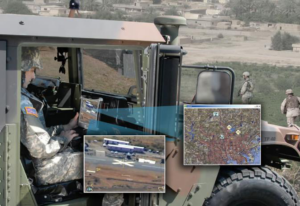OSRVT: Used In Combat But Can It Pass Testing
Posted on

Graduation season is ending, but some people are still waiting for final exam results. Take for example the Army offices that manage the General Atomics MQ-1C Gray Eagle — that service’s version of the armed Predator drone – and Textron’s One System Remote Video Terminal, a laptop soldiers on the ground can use to see a drone’s video and control its sensors. The latter tactic is known by the completely uneuphonious name of Manned Unmanned Teaming Level of Interoperability 3 (LoI3). Simple indirect receipt of a drone’s video is LoI 1, while full control of the aircraft, including takeoff and landing, would be LoI 5.
As the latest operational tests of the Gray Eagle, the OSRVT and various newer drone gear neared their June 14 end, Col. Courtney Cote, Army project manager for Unmanned Aircraft Systems (UAS), told a conference call with reporters that no AH-64 Apache helicopters were involved. “The Manned Unmanned Teaming was with the OSRVT…maneuvering with a Stryker brigade combat team and conducting Level of Interoperability 3 with the UASes that were maneuvering within their battle space,” Cote said.
Company F, 227th Aviation Regiment, 1st Air Cavalry Brigade, 1st Cavalry Division, out of Fort Hood, Texas, has been flying a full complement of 12 Gray Eagles for a Stryker brigade combat team using 22 “Dash 50” versions of the OSRVT in war games at the National Training Center at Fort Irwin, Calif., since May 29.
For the Gray Eagle, already in Full Rate Production (and sometimes spelled ‘Grey Eagle’), this was what acquisition regs call Follow On Operational Test and Evaluation. But for the OSRVT, this was the – nominally — far more important Initial Operational Test and Evaluation (IOT&E). According to the Director of Operational Test and Evaluation office at the Pentagon, IOT&E is a sort of final exam that determines whether a weapon or piece of equipment graduates to Full Rate Production.
The last grade the OSVRT got was not promising. In DOTE’s 2013 annual report, the Pentagon testers said that during Gray Eagle’s own IOT&E, the OSRVT was “generally not available, not clear, and not reliable. Integration of the Gray Eagle with a reliable remote video display system is not complete.” Still, more than 2,000 copies of the OSRVT have been used in combat in Afghanistan and Iraq – including 1,000 of the version tested at Fort Irwin. So Army officials are hardly awaiting the OSRVT’s recent test results with bated breath.
“The OSRVT really is a system that’s been resident in the Army for quite some time because of an operational need response,” Cote said. “Then it was formalized into a program of record and now, as a function of being a program of record, all systems are required to go through an operatonal test. That’s why it’s here.”
Col. Thomas von Eschenbach, Army Training and Doctrine Command capability manager of UAS, said the latest version of the OSRVT is far different from the one DOTE found inadequate in 2013.
“The OSRVT that is being tested is a capability that’s much more mobile, it’s lighter,” Eschenbach said. “It’s what we call bi-directional, meaning that the operator can take control of the payload of the unmanned system, whether that’s a Shadow or Gray Eagle, and maneuver the payload to where they want it based on the mission. Independent of this (recent testing), the OSRVT in its configuration, what it’s doing and how it’s doing it, is exactly what the Army needs for it to do.”
Or to put it another way: testing, schmesting.
Subscribe to our newsletter
Promotions, new products and sales. Directly to your inbox.
